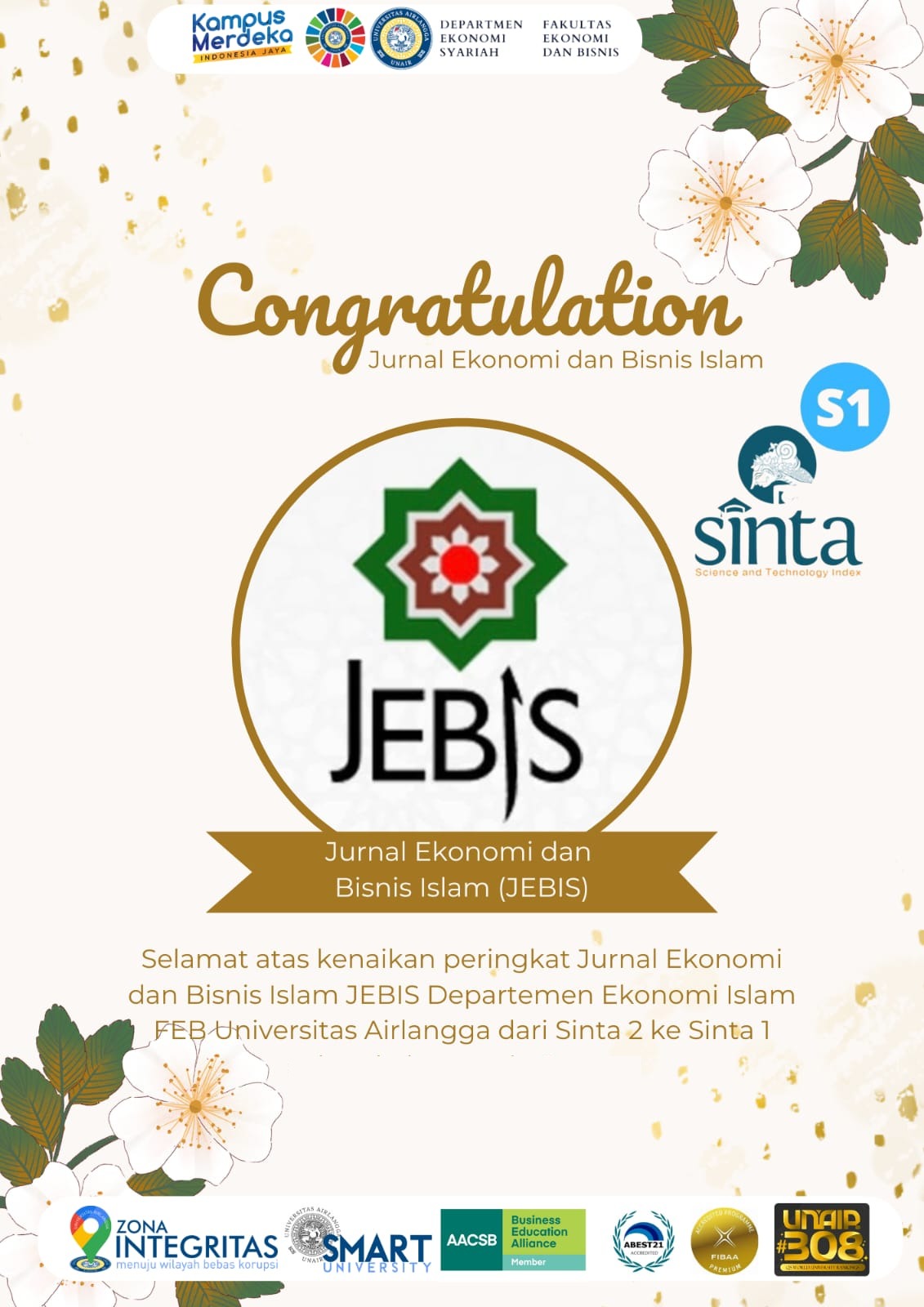NON-MUSLIM PERCEPTION OF ISLAMIC BANK: IS RELIGIOSITY MORE IMPORTANT THAN LOCATION, PROMOTION, & PRODUCTS
Downloads
Aliansyah, T., Hafasnuddin, H., & Shabri, S. (2012). Pengaruh Dimensi Kualitas Pelayanan terhadap Kepuasan Nasabah Bank Aceh Syariah Cabang Banda Aceh. Jurnal Manajemen Pascasarjana Universitas Syiah Kuala, 1(1), 32–39.
Ardiansyah, F., Siregar, H., Hakim, D. B., & Siregar, M. (2020). Determinants Affecing Profitability and Stock Returns for Smaller Banks Listed on The Indonesia Stock Exchange. Jurnal Aplikasi Bisnis Dan Manajemen, 6(3), 679. https://doi.org/10.17358/jabm.6.3.679
Bala, H. (2012). Socio-economic Influence of Sharia on Cosumers Motives and Perception in Zamfara State, Nigeria. International Journal of Psychosocial and Counselling, 4(4), 49–53. https://doi.org/10.5897/IJPC11.040
Berleant, A. (2005). Ideas for A Social Aesthetics. In The Aesthetics of Everyday Life (pp. 23–38). https://doi.org/10.17613/M6M61BP65
BPS. (2018). Report.
Crotty, M. (1998). Introduction: The Research Process. The Foundation of Social Research: Meaning and Perspective in The Research Process, 1–17.
Defourny, J., & Thorbecke, E. (1984). Structural Path Analysis and Multiplier Decomposition within a Social Accounting Matrix Framework. The Economic Journal, 94(373), 111–136. https://doi.org/10.2307/2232220
Delima, M., & Paramita, M. (2019). The Analysis of The Ease Access to Public Trust in Syariah Bank (Study Bank BRI Syarih KCP Palabuhanratu, Sukabumi). Jurnal Nisbah, 5(1), 75–82.
Fadhilah, A. (2018). Factors Affecting Non-Muslim Customers as A Customer in BCA Syariah Bank, Branch Yogyakarta. Universitas Islam Indonesia.
Hapsari, F. T., & Beik, I. S. (2014). Analisis Faktor-Faktor yang Memengaruhi Nasabah Non-Muslim dalam Menggunakan Jasa Bank Syariah di DKI Jakarta. Jurnal Al-Muzara'ah, 2(1), 75–95.
Hoepfl, M. C. (1997). Choosing Qualitative Research: A primer for Technology Education Researchers. Journal of Technology Education, 9(1), 47–63.
Idrus, M. (2009). Metode Penelitian Ilmu Sosial. PT Gelora Aksara Pratama.
IÅ¡oraitÄ—, M. (2016). Marketing Mix Theoritical Aspects. International Journal of Research Granthaalayah, 4(6), 25–37. https://doi.org/10.29121/granthaalayah.v4.i6.2016.2633
Kertajaya, H., & Sula, S. M. (2006). Syariah Marketing. PT Mizan Pustaka.
Khan, S. (2011). Impact of Rationality in Creating Consumer Motivation (A Study of State Life Insurance Corporation Peshawar - Pakistan). Journal of Managerial Sciences, 5(1), 97–103.
Khoirunissa, D. (2003). Consumers' Preference toward Islamic Banking (Case Study in Bank Muamalat Indonesia and Bank BNI Syariah). Jurnal Iqtisad, 4(2), 145–168. https://doi.org/10.20885/iqtisad.vol4.iss2.art3
Kotler, P., & Armstrong, G. (2010). Principles of marketing. Pearson education.
Lateh, N., Ismail, S., & Ariffin, N. M. (2009). Costumers' Perceptions on The Objectives Characteristics and Selection Criteria of Islamic Bank in Thailand. Gadjah Mada International Journal of Business, 11(2), 167–189. https://doi.org/10.22146/gamaijb.5525
Mokhlis, S. (2009). Relevancy and Measurement of Religiosity in Consumer Behavior Research. International Business Research, 2(3), 75–84.
Muhammad, M. (2007). Minat Berhubungan dengan Bank Syariah dan Wilayah Potensial Pengembangan Bank Syariah di Daerah Istimewa Yogyakarta. Sinergi: Kajian Bisnis Dan Manajemen, 9(2), 143–156. https://doi.org/10.20885/js.v9i2.57
OJK. (2021). Statistik Perbankan Syariah - Desember 2021.
Purwasono, L. D. (2019). Analisis Perilaku Konsumen dalam Pengambilan Keputusan terhadap Permintaan Jasa Ojek Online Berbasis Syariah (Studi pada Mahasiswi S1 Prodi Ekonomi Islam Fakultas Ekonomi dan Bisnis Universitas Brawijaya Malang). Jurnal Ilmiah Mahasiswa FEB Universitas Brawijaya, 7(2).
Rahmawaty, A. (2008). Analisis Pemicu Perbedaan Motivasi Nasabah Berafiliasi antara Bank Konvensional dan Bank Syariah di Semarang. In Kumpulan Makalah ACIS Penguatan Peran Perguruan Tinggi Agama Islam dalam Meningkatkan Daya Saing Bangsa.
Rifa'atul, M. (2009). Faktor-Faktor yang Mempengaruhi Minat Nasabah Non-Muslim menjadi Nasabah di Bank Syariah (Studi pada Bank CIMB Niaga Syariah Cabang Semarang). IAIN Walisongo.
Rusydiana, A. S., & Pamuncak, M. B. (2018). Measuring the Islamic Economic Index of ASEAN Countries. Maro, Jurnal Ekonomi Syariah Dan Bisnis, 1(2), 56–66.
Setiadi, N. J. (2008). Perilaku Konsumen: Konsep dan Implikasi untuk Strategi dan Penelitian Pemasaran. Kencana Prenada Media Group.
Swoboda, B., Pennemann, K., & Taube, M. (2012). The Effects of Perceived Brand Globalness and Perceived Brand Localness in China: Empirical Evidence on Western, Asian, and Domestic Retailers. Journal of International Marketing, 20(4), 72–95. https://doi.org/10.1509/jim.12.0105
Syafrina, N., & Manik, S. (2018). Faktor-Faktor yang Mempengaruhi Masyarakat Non-Muslim Menabung di PT Bank Syariah Mandiri. Jurnal Ekonomi Dan Bisnis Islam (JEBI), 3(1), 59–70.
Tjiptono, F. (2001). Strategi pemasaran edisi pertama. Yogyakarta: Andi Ofset.
Viranti, F. A., & Ginanjar, A. (2015). Influence of Facilities, Promotion, Product, and Location Islamic Banking on Decision Non Muslim Customers Patronizing at BRIS. Tauhidinomics: Journal of Islamic Banking and Economics, 1(1), 35–60.
Wahjono, S. I. (2010). Manajemen Pemasaran Bank. Graha Ilmu.
Wahyudi, D., & Prawita, S. (2014). Faktor-Faktor yang Mempengaruhi Perilaku Konsumen dalam Memilih Sepeda Motor Harley Davidson. Jurnal Ilman, 1(1), 83–92.
Yupitri, E., & Sari, R. L. (2012). Analisis Faktor-Faktor yang Mempengaruhi Non-Muslim menjadi Nasabah Bank Syariah Mandiri di Medan. Jurnal Ekonomi Dan Keuangan, 1(1), 46–60.
Zardo, P., Collie, A., & Livingstone, C. (2014). External Factors Affecting Decision-Making and Use of Evidence in An Australian Public Health Policy Environment. Social Sciences & Medicine, 108, 120–127. https://doi.org/10.1016/j.socscimed.2014.02.046
Zhao, S. X. B., Zhang, L., & Wang, D. T. (2004). Determining Factors of The Development of A National Financial Center: The Case fo China. Geoforum, 35(5), 577–592. https://doi.org/10.1016/j.geoforum.2004.01.004
Copyright (c) 2022 JEBIS (Jurnal Ekonomi dan Bisnis Islam) | JOURNAL OF ISLAMIC ECONOMICS AND BUSINESS

This work is licensed under a Creative Commons Attribution-NonCommercial-ShareAlike 4.0 International License.
- Every manuscript submitted to JEBIS must obey to the policy and terms set by Journal of Economics and Business Islamic.
- Publication rights on the contents of manuscript published by JEBIS is owned by JEBIS under consent and approval by the corresponding author(s).
- Full text of electronic publication of manuscripts can be accessed free if used for the purpose of education and research according to copyright regulation.
- Share ” copy and redistribute the material in any medium or format
- Adapt ” remix, transform, and build upon the material
- You must give appropriate credit, provide a link to the license, and indicate if changes were made. You may do so in any reasonable manner, but not in any way that suggests the licensor endorses you or your use.
- You may not use the material for commercial purposes.
- If you remix, transform, or build upon the material, you must distribute your contributions under the same license as the original.
Creative Commons Attribution-NonCommercial-ShareAlike 4.0 International License.





.png)














